Application of the Reformulated Gash Analytical Model for Rainfall Interception Loss to Unmanaged High-Density Coniferous Plantations Laden with Dead Branches
Abstract
1. Introduction
2. Materials and Methods
2.1. Study Site
2.2. Measurement of Throughfall and Stemflow
2.3. Measurement of Meteorological Data
2.4. Application of RGAM
2.5. Parameter Estimation for RGAM
2.6. Model Evaluation
- extremely good (error ≤ 1%)
- very good (1% < error ≤ 5%)
- good (5% < error ≤ 10%)
- fair (10% < error ≤ 30%)
- bad (error > 30%).
2.7. Sensitivity Analysis
- (1)
- forest structure parametersstand-related: zo, canopy-related: c, trunk-related: ptcanopy storage-related: S, trunk storage-related: Stevaporation-related:
- (2)
- climate parameter: .
3. Results
3.1. Interception Loss
3.2. Parameters for RGAM
3.3. Performance of RGAM
3.4. Sensitivity Analysis
4. Discussion
4.1. Applicability of RGAM IL Estimation
4.2. Characteristics of IL Processes in the Unmanaged Plantations
5. Conclusions
Author Contributions
Funding
Data Availability Statement
Acknowledgments
Conflicts of Interest
References
- Sun, X.; Onda, Y.; Kato, H. Incident rainfall partitioning and canopy interception modeling for an abandoned Japanese cypress stand. J. For. Res. 2014, 19, 317–328. [Google Scholar] [CrossRef]
- Komatsu, H. Modeling evapotranspiration changes with managing Japanese cedar and cypress plantations. For. Ecol. Manag. 2020, 475, 118395. [Google Scholar] [CrossRef]
- Oda, T.; Egusa, T.; Ohte, N.; Hotta, N.; Tanaka, N.; Green, M.B.; Suzuki, M. Effects of changes in canopy interception on stream runoff response and recovery following clear-cutting of a Japanese coniferous forest in Fukuroyamasawa Experimental Watershed in Japan. Hydrol. Process. 2021, 35, e14177. [Google Scholar] [CrossRef]
- Komatsu, H.; Tanaka, N.; Kume, T. Do coniferous forests evaporate more water than broad-leaved forests in Japan? J. Hydrol. 2007, 336, 361–375. [Google Scholar] [CrossRef]
- Llorens, P.; Domingo, F. Rainfall partitioning by vegetation under Mediterranean conditions. A review of studies in Europe. J. Hydrol. 2007, 335, 37–54. [Google Scholar] [CrossRef]
- Sun, X.; Onda, Y.; Kato, H.; Gomi, K.; Komatsu, H. Effect of strip thinning on rainfall interception in a Japanese cypress plantation. J. Hydrol. 2015, 525, 607–618. [Google Scholar] [CrossRef]
- Sun, X.; Onda, Y.; Otsuki, K.; Kato, H.; Gomi, T.; Liu, X. Change in evapotranspiration partitioning after thinning in a Japanese cypress plantation. Trees 2017, 31, 1411–1421. [Google Scholar] [CrossRef]
- Shinohara, Y.; Levia, D.F.; Komatsu, H.; Nogata, M.; Otsuki, K. Comparative modeling of the effects of intensive thinning on canopy interception loss in a Japanese cedar (Cryptomeria japonica D. Don) forest of western Japan. Agric. For. Meteorol. 2015, 214–215, 148–156. [Google Scholar] [CrossRef]
- Yue, K.; De Frenne, P.; Fornara, D.A.; Van Meerbeek, K.; Li, W.; Peng, X.; Ni, X.; Peng, Y.; Wu, F.; Yang, Y.; et al. Global patterns and drivers of rainfall partitioning by trees and shrubs. Glob. Change Biol. 2021, 27, 3350–3357. [Google Scholar] [CrossRef]
- Teklehaimanot, Z.; Jarvis, P.G.; Ledger, D.C. Rainfall interception and boundary layer conductance in relation to tree spacing. J. Hydrol. 1991, 123, 261–278. [Google Scholar] [CrossRef]
- Komatsu, H.; Shinohara, Y.; Otsuki, K. Models to predict changes in annual runoff with thinning and clearcutting of Japanese cedar and cypress plantations in Japan. Hydrol. Process. 2015, 29, 5120–5134. [Google Scholar] [CrossRef]
- Crockford, R.H.; Richardson, D.P. Partitioning of rainfall into throughfall, stemflow and interception: Effect of forest type, ground cover and climate. Hydrol. Process. 2000, 14, 2903–2920. [Google Scholar] [CrossRef]
- Muzylo, A.; Llorens, P.; Valente, F.; Keizer, J.J.; Domingo, F.; Gash, J.H.C. A review of rainfall interception modelling. J. Hydrol. 2009, 370, 191–206. [Google Scholar] [CrossRef]
- Deguchi, A.; Hattori, S.; Park, H.T. The influence of seasonal changes in canopy structure on interception loss: Application of the revised Gash model. J. Hydrol. 2006, 318, 80–102. [Google Scholar] [CrossRef]
- Iida, S.; Levia, D.F.; Shimizu, A.; Shimizu, T.; Tamai, K.; Nobuhiro, T.; Kebeya, N.; Noguchi, S.; Sawano, S.; Araki, M. Intrastorm scale rainfall interception dynamics in a mature coniferous forest stand. J. Hydrol. 2017, 548, 770–783. [Google Scholar] [CrossRef]
- Jeong, S.; Otsuki, K.; Inoue, A.; Shinohara, Y. Marked difference of rainfall partitioning in an unmanaged coniferous plantation with high stand density. J. For. Res. 2019, 24, 107–114. [Google Scholar] [CrossRef]
- Jeong, S.; Otsuki, K.; Farahnak, M. Relationship between stand structures and rainfall partitioning in dense unmanaged Japanese cypress plantations. J. Agric. Meteorol. 2019, 75, 92–102. [Google Scholar] [CrossRef]
- Japan Forestry Agency. Annual Report on Trends in Forest and Forestry Fiscal Year 2017; Summary; Ministry of Agriculture, Forestry and Fisheries: Japan, Tokyo, 2018; p. 30. Available online: https://www.rinya.maff.go.jp/j/kikaku/hakusyo/29hakusyo/attach/pdf/index-1.pdf (accessed on 22 February 2022).
- Onda, Y.; Gomi, T.; Mizugaki, S.; Nonoda, T.; Sidle, R.C. An overview of the field and modeling studies on the effect of forest devastation on flooding and environmental issues. Hydrol. Process. 2010, 24, 527–534. [Google Scholar] [CrossRef]
- Fujimori, T. Dynamics of crown structure and stem growth based on knot analysis of a hinoki cypress. For. Ecol. Manag. 1993, 56, 57–68. [Google Scholar] [CrossRef]
- Jeong, S.; Otsuki, K. Effects of tree mortality on the estimation of stemflow yield in a self-thinning coniferous plantations. Ecohydrology 2021, 14, e2327. [Google Scholar] [CrossRef]
- Nanko, K.; Mizugaki, S.; Onda, Y. Estimation of soil splash detachment rates on the forest floor of an unmanaged Japanese cypress plantation based on field measurements of throughfall drop size and velocities. Catena 2008, 72, 348–361. [Google Scholar] [CrossRef]
- Shinohara, Y.; Ichinose, K.; Morimoto, M.; Kubota, T.; Nanko, K. Factors influencing the erosivity indices of raindrops in Japanese cypress plantations. Catena 2018, 171, 54–61. [Google Scholar] [CrossRef]
- Merriam, R. A note on the interception loss equation. J. Geophys. Res. 1960, 65, 3850–3851. [Google Scholar] [CrossRef]
- Zinke, P.J. Forest interception studies in the United States. In Forest Hydrology; Sopper, W.E., Lull, H.W., Eds.; Pergamon Press: Oxford, NY, USA, 1967; pp. 29–40. [Google Scholar]
- Rutter, A.J.; Kershaw, K.A.; Robins, P.C.; Morton, A.J. A predictive model of rainfall interception in forests, 1. Derivation of the model from observations in a plantation of Corsican pine. Agric. Meteorol. 1971, 9, 367–384. [Google Scholar] [CrossRef]
- Rutter, A.J.; Mortin, A.J.; Robbins, P.C. A predictive model of rainfall interception in forests. 2. Generalization of the model and comparison with observations in some coniferous and hardwood stands. J. Appl. Ecol. 1975, 12, 367–380. [Google Scholar] [CrossRef]
- Gash, J.H.C. An analytical model of rainfall interception in forests. Q. J. R. Meteorol. Soc. 1979, 105, 43–55. [Google Scholar] [CrossRef]
- Gash, J.H.C.; Lloyd, C.R.; Lachaud, G. Estimating sparse forest rainfall interception with an analytical model. J. Hydrol. 1995, 170, 79–86. [Google Scholar] [CrossRef]
- Calder, I.R. A stochastic model of rainfall interception. J. Hydrol. 1986, 89, 65–71. [Google Scholar] [CrossRef]
- Nagano, M.; Inoue, A.; Sankoda, K.; Miyazawa, Y.; Maruyama, A.; Takagi, M.; Otsuki, K. Observation of Canopy Interception Ratio in Old-aged Low-density Japanese Cypress Plantations in the Aso District, Southern Japan. J. Jpn. For. Soc. 2017, 99, 70–73. [Google Scholar] [CrossRef]
- Kimmins, J.P. Some statistical aspects of sampling throughfall precipitation in natural cycling studies in British Columbian coastal forests. Ecology 1973, 54, 1008–1019. [Google Scholar] [CrossRef]
- Saito, T.; Matsuda, H.; Komatsu, M.; Xiang, Y.; Takahashi, A.; Shinohara, Y.; Otsuki, K. Forest canopy interception loss exceeds wet canopy evaporation in Japanese cypress (Hinoki) and Japanese cedar (Sugi) plantations. J. Hydrol. 2013, 507, 287–299. [Google Scholar] [CrossRef]
- Pypker, T.G.; Bond, B.J.; Link, T.E.; Marks, D.; Unsworth, M.H. The importance of canopy structure in controlling the interception loss of rainfall: Examples from a young and an old-growth Douglas-fir forest. Agric. For. Meteorol. 2005, 130, 113–129. [Google Scholar] [CrossRef]
- Sadeghi, S.M.M.; Attarod, P.; Van Stan, J.T.; Pypker, T.G.; Dunkerley, D. Efficiency of the reformulated Gash’s interception model in semiarid afforestations. Agric. For. Meteorol. 2015, 201, 76–85. [Google Scholar] [CrossRef]
- Tu, L.; Xiong, W.; Wang, Y.; Yu, P.; Liu, Z.; Han, X.; Yu, Y.; Shi, Z.; Guo, H.; Li, Z.; et al. Integrated effects of rainfall regime and canopy structure on interception loss: A comparative modelling analysis for an artificial larch forest. Ecohydrology 2021, 14, e2283. [Google Scholar] [CrossRef]
- Link, E.T.; Unsworth, M.; Marks, D. The dynamics of rainfall interception by a seasonal temperate rainforest. Agric. For. Meteorol. 2004, 124, 171–191. [Google Scholar] [CrossRef]
- Wallace, J.; McJannet, D. On interception modelling of a lowland coastal rainforest in northern Queensland, Australia. J. Hydrol. 2006, 329, 477–488. [Google Scholar] [CrossRef]
- Klaassen, W.; Bosveld, F.; de Water, E. Water storage and evaporation as constituents of rainfall interception. J. Hydrol. 1998, 212–213, 36–50. [Google Scholar] [CrossRef]
- Leyton, L.; Reynolds, E.R.C.; Thompson, F.B. Rainfall interception in forests and moorland. In International Symposium on Forest Hydrology; Sooper, W.E., Lull, H.W., Eds.; Pergamon Press: Oxford, NY, USA, 1967; pp. 163–178. [Google Scholar]
- Nakai, T.; Sumida, A.; Daikoku, K.; Matsumoto, K.; van der Molen, M.; Kodama, Y.; Kononov, A.; Maximov, T.C.; Dolman, A.; Yabuki, H.; et al. Parameterisation of aerodynamic roughness over boreal, cool- and warm-temperate forests. Agric. For. Meteorol. 2008, 148, 1916–1925. [Google Scholar] [CrossRef]
- Pearce, A.; Gash, J.; Stewart, J. Rainfall interception in a forest stand estimated from grassland meteorological data. J. Hydrol. 1980, 46, 147–163. [Google Scholar] [CrossRef]
- Ingleby, B.; Moore, D.; Cloan, C.; Dunn, R. Evolution and accuracy of surface humidity reports. J. Hydrometeorol. 2013, 30, 2025–2043. [Google Scholar] [CrossRef]
- Murakami, S. Application of three canopy interception models to a young stand of Japanese cypress and interpretation in terms of interception mechanism. J. Hydrol. 2007, 342, 305–319. [Google Scholar] [CrossRef]
- Rana, G.; Katerji, N. A measurement based sensitivity analysis of the Penman-Monteith actual evapotranspiration model for crops of different height and in contrasting water satus. Theor. Appl. Climatol. 1998, 60, 141–149. [Google Scholar] [CrossRef]
- Pereira, F.L.; Valente, F.; David, J.S.; Jackson, N.; Minunno, F.; Gash, J.H. Rainfall interception modelling: Is the wet bulb approach adequate to estimate mean evaporation rate from wet/saturated canopies in all forest types? J. Hydrol. 2016, 534, 606–615. [Google Scholar] [CrossRef][Green Version]
- Nanko, K.; Onda, Y.; Ito, A.; Moriwaki, H. Effect of canopy thickness and canopy saturation on the amount and kinetic energy of throughfall: An experimental approach. Geophys. Res. Lett 2008, 35, L05401. [Google Scholar] [CrossRef]
- Levia, D.F.; Hudson, S.A.; Llorens, P.; Nanko, K. Throughfall drop size distributions: A review and prospectus for future research. Wiley Interdiscip. Rev. Water 2017, 4, e1225. [Google Scholar] [CrossRef]
- Levia, D.F.; Nanko, K.; Amasaki, H.; Giambelluca, T.W.; Hotta, N.; Iida, S.; Mudd, R.G.; Nullet, M.A.; Sakai, N.; Shinohara, Y.; et al. Throughfall partitioning by trees. Hydrol. Process. 2019, 33, 1698–1708. [Google Scholar] [CrossRef]
- Iida, S.; Levia, D.F.; Nanko, K.; Sun, X.; Shimizu, T.; Tamaki, K.; Shinohara, Y. Correction of canopy interception loss measurements in temperate forests: A comparison of necessary adjustments among three different rain gauges based on a dynamic calibration procedure. J. Hydrometeorol. 2018, 19, 547–553. [Google Scholar] [CrossRef]
- Linhoss, A.C.; Siegert, C.M. A comparison of five forest interception models using global sensitivity and uncertainty analysis. J. Hydrol. 2016, 538, 109–116. [Google Scholar] [CrossRef]
- Hutchings, N.J.; Milne, R.; Crowther, J.M. Canopy storage capacity and its vertical distribution in a Sitka spruce canopy. J. Hydrol. 1988, 104, 161–171. [Google Scholar] [CrossRef]
- Eliades, M.; Bruggeman, A.; Djuma, H.; Christou, A.; Rovanias, K.; Lubczynski, M.W. Testing three rainfall interception models and different parameterization methods with data from an open Mediterranean pine forest. Agric. For. Meteorol. 2022, 313, 108755. [Google Scholar] [CrossRef]
- Valente, F.; Gash, J.H.; Nóbrega, C.; David, J.S.; Pereira, F.L. Modelling rainfall interception by an olive-grove/pasture system with a sparse tree canopy. J. Hydrol. 2019, 581, 124417. [Google Scholar] [CrossRef]
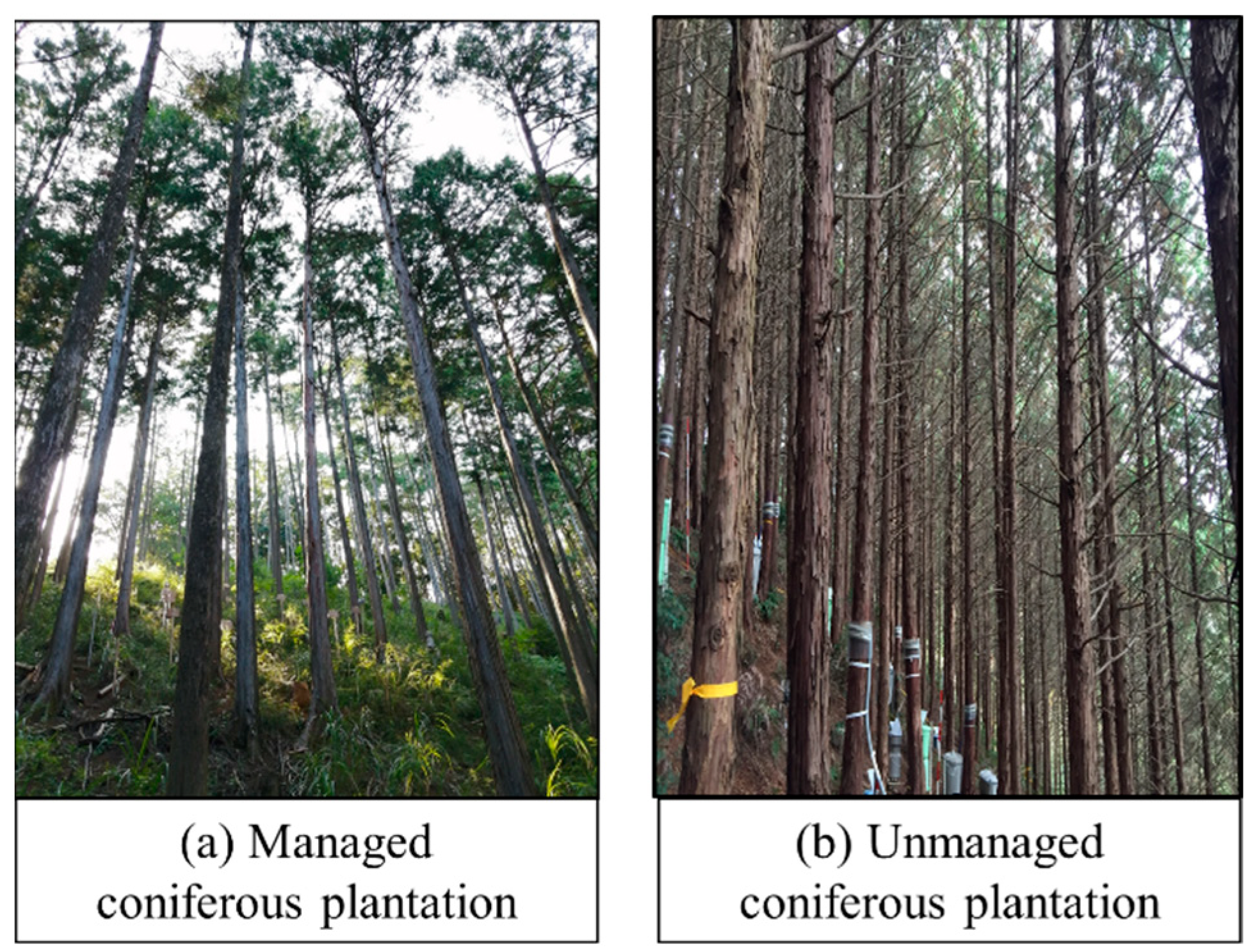
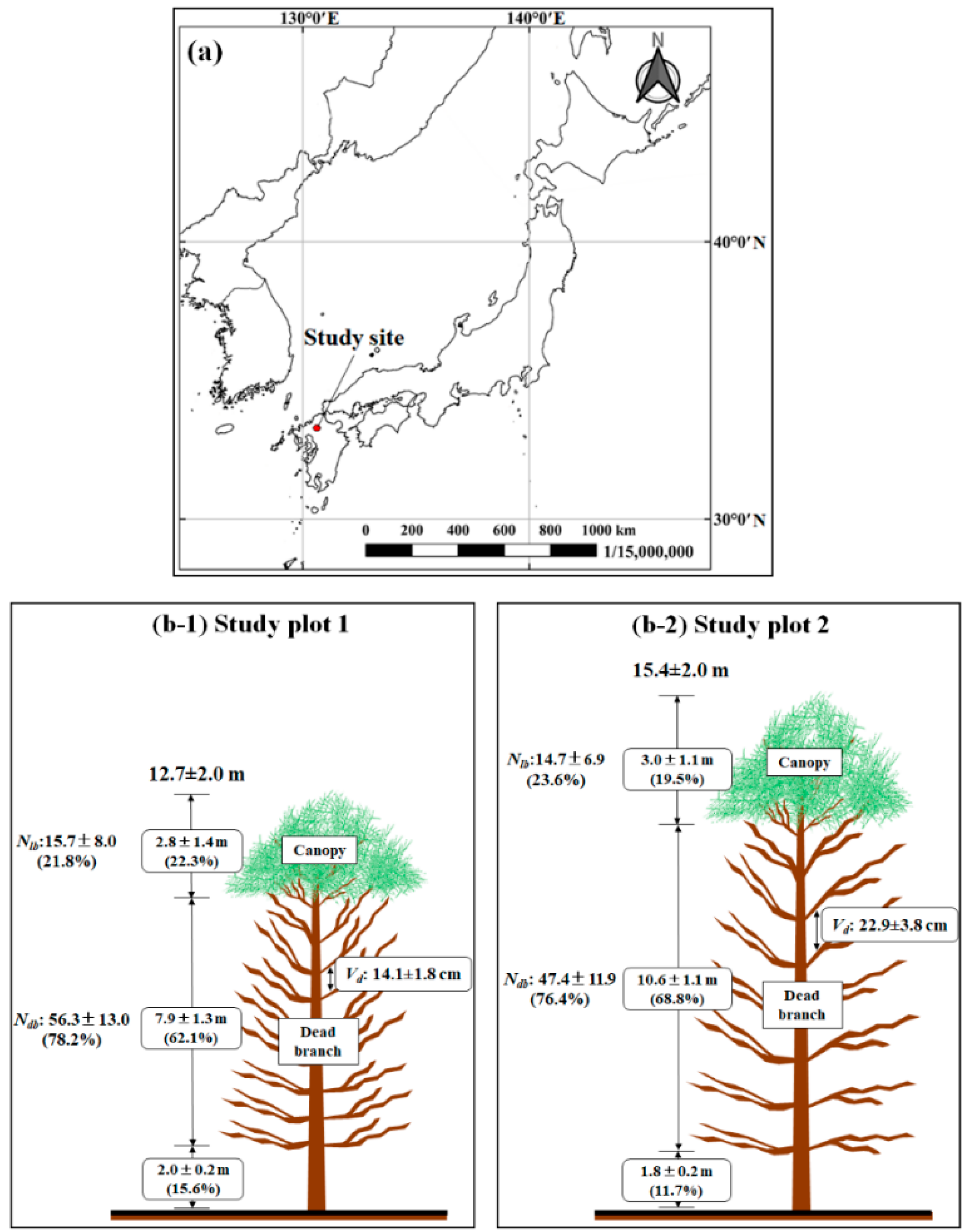
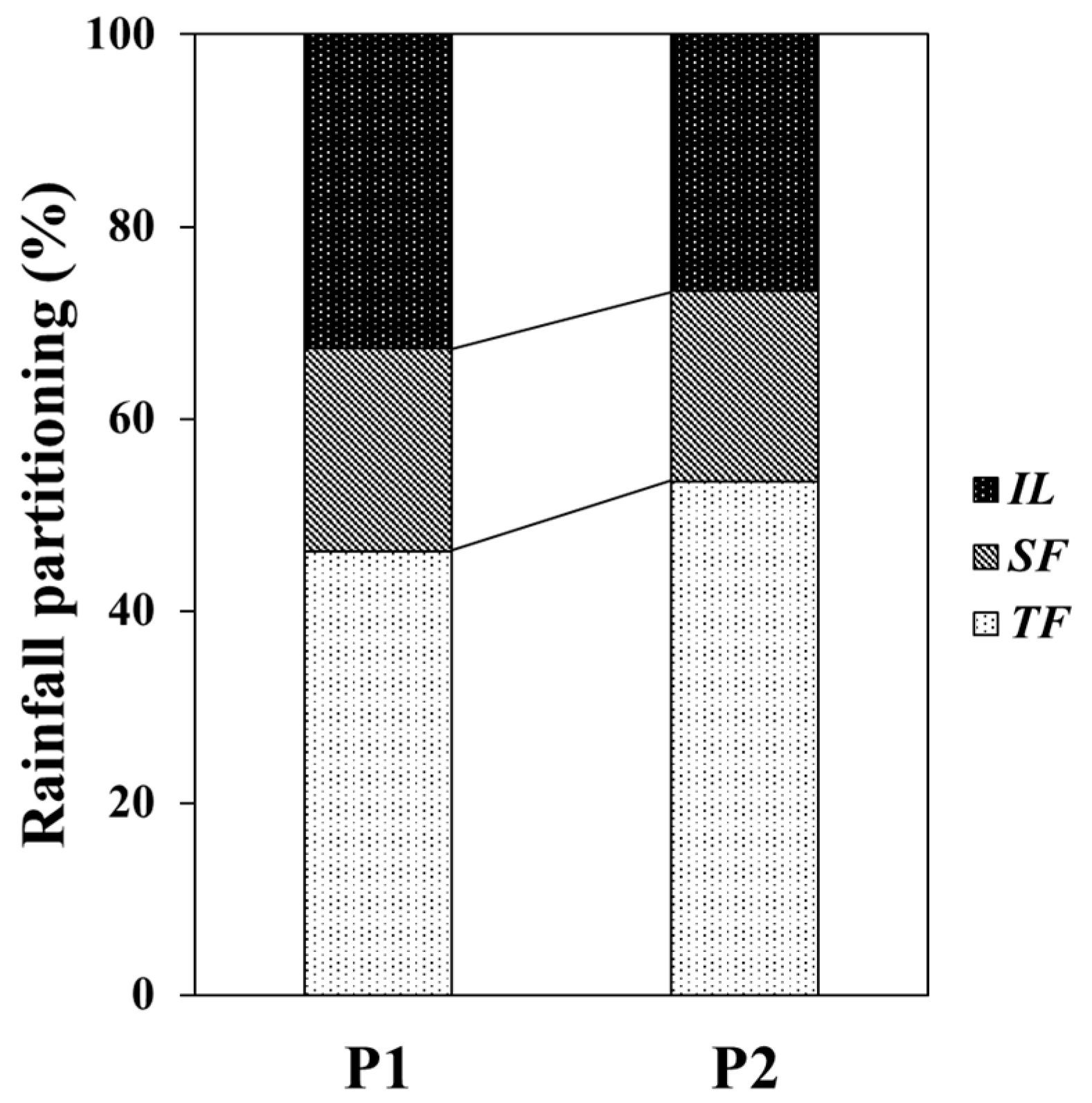
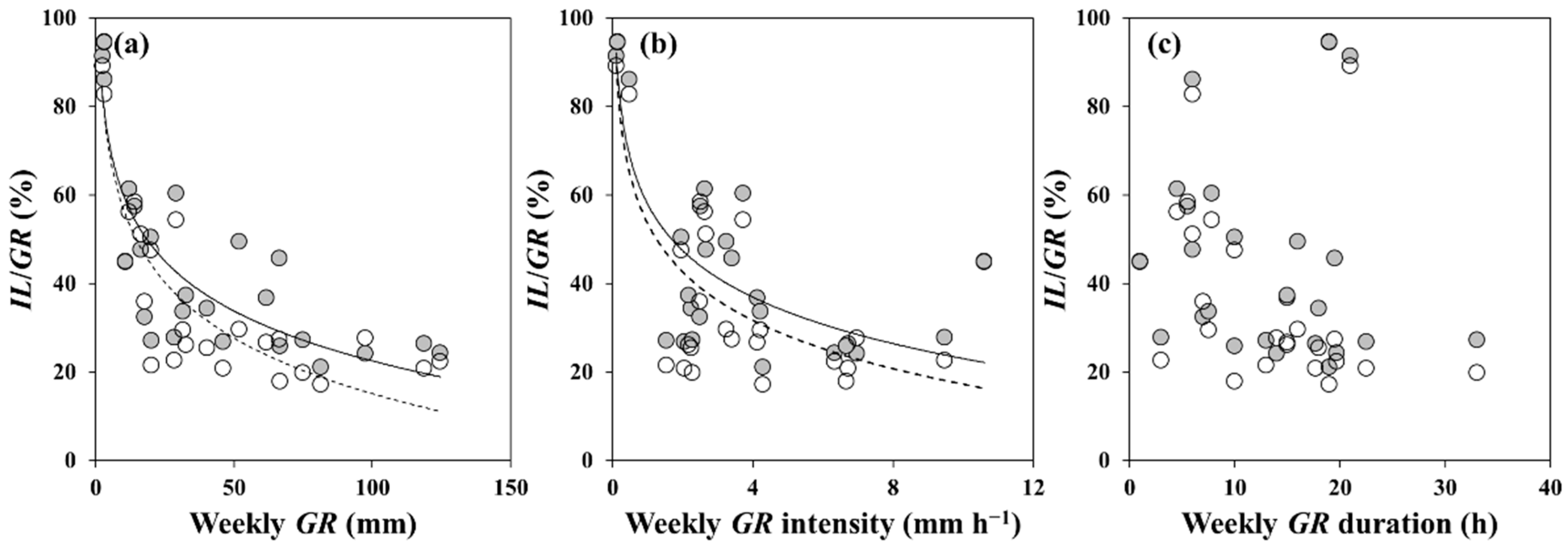

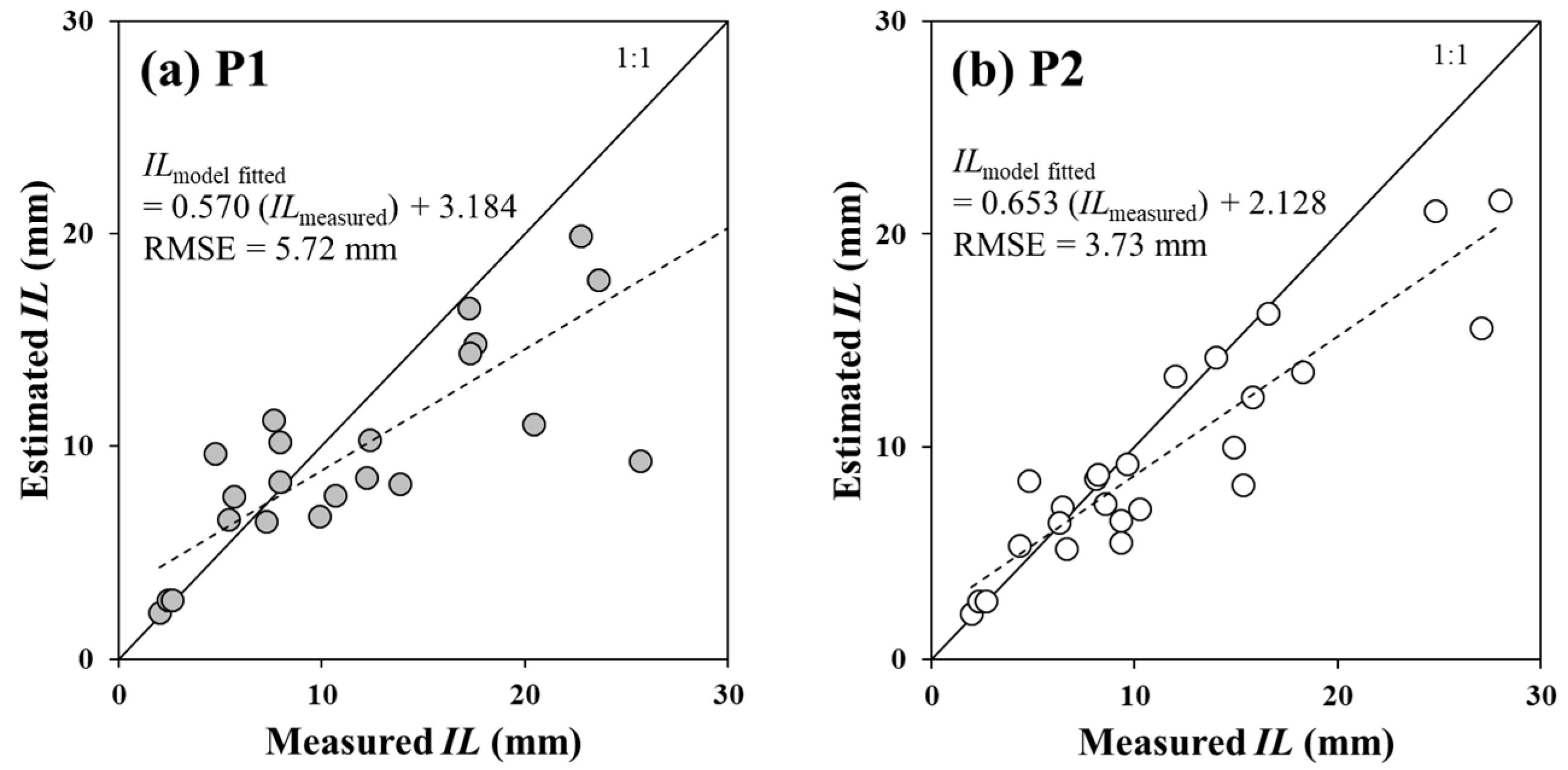
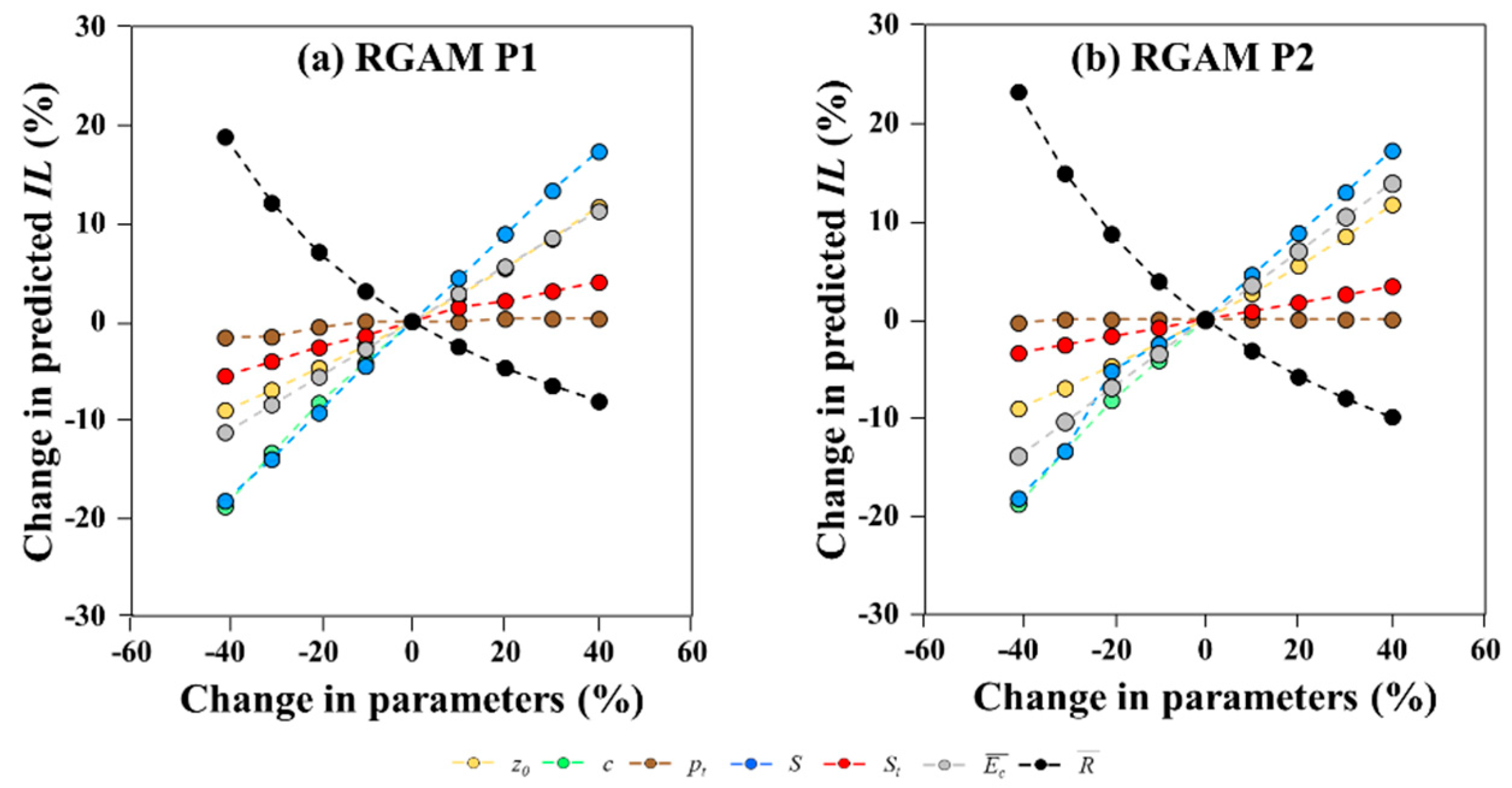
| Forest Stand Structure | P1 | P2 |
|---|---|---|
| General stand structure | ||
| a The number of trees (Ntree) | 50 (45 + 5) | 50 (45 + 5) |
| Tree age (years) | 33 | 33 |
| b Stand density (SD, stems ha−1) | 2250 (2500 − 250) | 2250 (2500 − 250) |
| Stand structure | ||
| c Diameter at breast height (DBH, cm) | 17.7 ± 4.1 | 20.4 ± 4.1 |
| d Tree height (h, m) | 12.7 ± 2.0 | 15.4 ± 2.0 |
| c Basal area (BA, m2 ha−1) | 64.9 | 85.2 |
| e Plant area index (PAI, m2 m−2) | 5.6 ± 0.2 | 6.4 ± 0.2 |
| Upper-canopy structure | ||
| f The number of live branches (Nlb) | 15.7 (21.8%) | 14.7 (23.6%) |
| d Canopy length (CL, m) | 2.8 ± 1.4 | 3.0 ± 1.1 |
| g Canopy projection area (CPA, m2) | 4.8 ± 1.8 | 4.7 ± 1.9 |
| e Canopy cover (c, %) | 99.3 ± 0.1 | 99.6 ± 0.1 |
| Under-canopy structure | ||
| f The number of dead branches (Ndb) | 56.3 (78.2%) | 47.4 (76.4%) |
| h Vertical distance of dead branches (Vd, cm) | 14.1 ± 1.8 | 22.9 ± 3.8 |
| Forest Structure Parameters | Climate Parameter | |||||||||
|---|---|---|---|---|---|---|---|---|---|---|
| Study | Species | SD | PAI | Stand-Related | Canopy-Related | Trunk-Related | Canopy Storage-Related | Trunk Storage-Related | Evaporation-Related | |
| zoa | cb | ptc | Sd | Ste | f | g | ||||
| Stems ha−1 | m2 m−2 | m | mm | mm | mm h−1 | mm h−1 | ||||
| Present study | ||||||||||
| This study (P1) | Cypress | 2250 | 5.6 | 0.85 | 0.99 | 0.24 | 3.94 1 | 1.19 | 0.23 | 2.84 |
| This study (P2) | Cypress | 2250 | 6.4 | 0.95 | 1.00 | 0.21 | 3.25 1 | 0.58 | 0.24 | 2.84 |
| Previous studies | ||||||||||
| [6] * | Cypress | 2198 | − | 1.60 | 0.97 | 0.12 | 2.42 2 | 0.39 | 0.38 | 2.37 |
| [6] ** | Cypress | 1099 | − | 1.60 | 0.76 | 0.09 | 1.54 2 | 0.34 | 0.32 | 3.46 |
| [8] * | Cedar | 1300 | 4.8 | 4.41 | 0.98 | 0.16 | 1.34 1 | 0.61 | 0.28 | 2.75 |
| [8] ** | Cedar | 600 | 2.4 | 1.63 | 0.86 | 0.07 | 0.83 1 | 0.42 | 0.06 | 1.44 |
| Components | P1 | P2 | ||||
|---|---|---|---|---|---|---|
| Modeled IL (mm) | Proportion of IL (%) | Estimated Error (%) | Modeled IL (mm) | Proportion of IL (%) | Estimated Error (%) | |
| For storms GR < GR′ (ILinsuf) | ||||||
| Evaporation from canopy | 26.2 | 9.4 | 22.3 | 9.3 | ||
| For storms GR ≥ GR′ (ILsuf) | ||||||
| Wetting up the canopy (ILw) | 5.8 | 2.1 | 5.1 | 2.1 | ||
| Wet canopy evaporation during the storms (ILs) | 73.1 | 26.2 | 78.3 | 32.7 | ||
| Evaporation after storms ceased (ILd) | 134.0 | 48.1 | 113.6 | 47.4 | ||
| Evaporation from trunks (ILt) | 39.7 | 14.2 | 20.3 | 8.5 | ||
| Total estimated IL | 278.7 | 100.0 | −20.2 | 239.6 | 100.0 | −16.1 |
| Total measured IL | 349.4 | − | 285.5 | − | ||
Publisher’s Note: MDPI stays neutral with regard to jurisdictional claims in published maps and institutional affiliations. |
© 2022 by the authors. Licensee MDPI, Basel, Switzerland. This article is an open access article distributed under the terms and conditions of the Creative Commons Attribution (CC BY) license (https://creativecommons.org/licenses/by/4.0/).
Share and Cite
Jeong, S.; Kume, T.; Shinohara, Y.; Farahnak, M.; Otsuki, K. Application of the Reformulated Gash Analytical Model for Rainfall Interception Loss to Unmanaged High-Density Coniferous Plantations Laden with Dead Branches. Forests 2022, 13, 657. https://doi.org/10.3390/f13050657
Jeong S, Kume T, Shinohara Y, Farahnak M, Otsuki K. Application of the Reformulated Gash Analytical Model for Rainfall Interception Loss to Unmanaged High-Density Coniferous Plantations Laden with Dead Branches. Forests. 2022; 13(5):657. https://doi.org/10.3390/f13050657
Chicago/Turabian StyleJeong, Seonghun, Tomonori Kume, Yoshinori Shinohara, Moein Farahnak, and Kyoichi Otsuki. 2022. "Application of the Reformulated Gash Analytical Model for Rainfall Interception Loss to Unmanaged High-Density Coniferous Plantations Laden with Dead Branches" Forests 13, no. 5: 657. https://doi.org/10.3390/f13050657
APA StyleJeong, S., Kume, T., Shinohara, Y., Farahnak, M., & Otsuki, K. (2022). Application of the Reformulated Gash Analytical Model for Rainfall Interception Loss to Unmanaged High-Density Coniferous Plantations Laden with Dead Branches. Forests, 13(5), 657. https://doi.org/10.3390/f13050657







